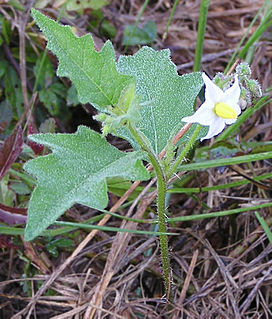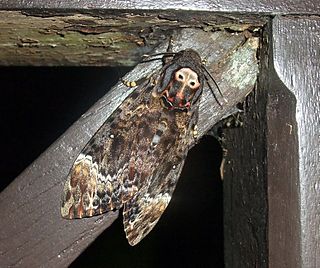Related Research Articles

Eggplant, aubergine or brinjal is a plant species in the nightshade family Solanaceae. Solanum melongena is grown worldwide for its edible fruit.

Solanum is a large and diverse genus of flowering plants, which include three food crops of high economic importance, the potato, the tomato and the eggplant. It also contains the nightshades and horse nettles, as well as numerous plants cultivated for their ornamental flowers and fruit.

Solanum carolinense, the Carolina horsenettle, is not a true nettle, but a member of the Solanaceae, or nightshade family. It is a perennial herbaceous plant, native to the southeastern United States that has spread widely throughout much of temperate North America. It has also been found in parts of Europe, Asia, and Australia. The stem and undersides of larger leaf veins are covered with spines.

Manduca blackburni, the Hawaiian tomato hornworm, Hawaiian tobacco hornworm or Blackburn's sphinx moth, is a moth in the family Sphingidae. The species was first described by Arthur Gardiner Butler in 1880. It is endemic to Hawaii. Previously known from all of the main islands, this rare moth is now limited to Maui, the Big Island, and Kahoʻolawe. It is found in coastal mesic and dry forests at elevations from sea level 5,000 ft (1,500 m).

Acherontia lachesis, the greater death's head hawkmoth or bee robber, is a large sphingid moth found in India, Sri Lanka and much of the Oriental region. It is one of the three species of death's-head hawkmoth genus, Acherontia. The species was first described by Johan Christian Fabricius in 1798. It is nocturnal and very fond of honey; they can mimic the scent of honey bees so that they can enter a hive unharmed to get honey. Their tongue, which is stout and very strong, enables them to pierce the wax cells and suck the honey out. This species occurs throughout almost the entire Oriental region, from India, Pakistan and Nepal to the Philippines, and from southern Japan and the southern Russian Far East to Indonesia, where it attacks colonies of several different honey bee species. It has recently become established on the Hawaiian Islands.

Diplopseustis is a genus of snout moths in the subfamily Lathrotelinae of the family Crambidae. It was described in 1884 be Edward Meyrick with Cymoriza minimaButler, 1881 as its type species, which is now considered a synonym of Diplopseustis perieresalis.

Neoleucinodes is a genus of snout moths of the subfamily Spilomelinae in the family Crambidae. The genus was described by Hahn William Capps in 1948 as a Neotropical split-off of the Old World genus Leucinodes.

Scrobipalpa aptatella is a moth of the family Gelechiidae. It is found in China (Xinjiang), Australia, New Zealand, Samoa, India, Indonesia (Sumatra), Malaysia, Myanmar, Sri Lanka, Palestine and in Africa, where it has been recorded from the Democratic Republic of Congo, Kenya, Malawi, Namibia, South Africa, Tanzania and Zimbabwe.

Keiferia lycopersicella, the tomato pinworm, is a moth of the family Gelechiidae. It is found in warm areas in Mexico, California, Texas, Georgia, Florida, Hawaii, Cuba, Hispaniola and the Bahamas. It has also been reported from greenhouses in Delaware, Mississippi, Missouri, Pennsylvania and Virginia.

Neoleucinodes elegantalis is a moth of the family Crambidae described by Achille Guenée in 1854. It ìs found in Mexico, Costa Rica, Cuba, Honduras, Grenada, Guatemala, Jamaica, Panama, Puerto Rico, Trinidad and Tobago, Argentina, Brazil, Colombia, Ecuador, Guyana, Paraguay, Peru, Suriname, Uruguay and Venezuela.
Rhectocraspeda periusalis, the eggplant webworm moth, is a moth in the family Crambidae. It was described by Francis Walker in 1859. It is found in the West Indies and from the United States, where it has been recorded from Florida, North Carolina, Ohio, Oklahoma, South Carolina and Tennessee, south through Mexico and Central America to South America, including Ecuador, Brazil, Guyana, Trinidad and Tobago and Suriname.

Lineodes integra, the eggplant leafroller moth or nightshade leaftier, is a moth of the family Crambidae. It is found from the southern United States, south to Chile. It has also been recorded from Illinois, Michigan, Ontario and Cuba.
Neoleucinodes dissolvens is a moth in the family Crambidae. It was described by Harrison Gray Dyar Jr. in 1914. It is found in French Guiana, Ecuador, Suriname and Brazil.
Neoleucinodes imperialis is a moth in the family Crambidae. It was described by Achille Guenée in 1854. It is found in Haiti, Honduras, Costa Rica, Panama and the Brazilian states of Paraná, Minas Gerais and Rio de Janeiro.
Neoleucinodes incultalis is a moth in the family Crambidae. It was described by Schaus in 1912. It is found in Costa Rica.
Neoleucinodes silvaniae is a moth in the family Crambidae. It was described by Ana Elizabeth Diaz and Maria Alma Solis in 2007. It is found in Colombia.
Neoleucinodes torvis is a moth in the family Crambidae. It was described by Hahn William Capps in 1948. It is found in Cuba, Puerto Rico, Jamaica, Grenada, Dominica, the Virgin Islands, St. Croix, Mexico, Guatemala, Panama, Peru, Brazil, Guyana, Suriname and French Guiana.

Leucinodes cordalis, the poroporo fruit borer or eggfruit caterpillar, is a species of moth in the family Crambidae. It is found in New Zealand, Australia and Indonesia (Sulawesi). In Australia, it has been reported from Norfolk Island, the Northern Territory, Queensland, New South Wales, the Australian Capital Territory, Victoria, Tasmania and South Australia. The species was first described by Henry Doubleday in 1843.

Lineodini is a tribe of the species-rich subfamily Spilomelinae in the snout moth family Crambidae.
References
- ↑ "GlobIZ search". Global Information System on Pyraloidea. Retrieved 2014-07-15.
- ↑ Neoleucinodes at Markku Savela's Lepidoptera and Some Other Life Forms
- ↑ Moth Photographers Group at Mississippi State University
- ↑ "Microlepidoptera on Solanaceae | Fact Sheet: Neoleucinodes prophetica". idtools.org.
| This Lineodini-related article is a stub. You can help Wikipedia by expanding it. |